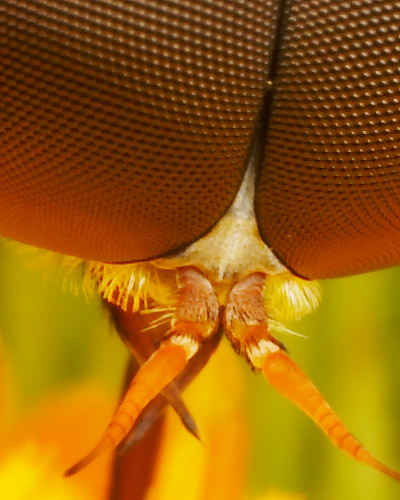
A long-tongued horse fly takes a sip of nectar in Arizona's Chiricahua mountains.

100% crop of the same image.
photo details: Canon 65mm MP-E 1-5x macro lens on a Canon EOS 20D
ISO 100, f/13, 1/250 sec, flash diffused through tracing paper
More like this
tags: Mexican Long-tongued Bats, Choeronycteris mexicana,
It seems giraffes are now considered kosher:
Behold the spectacularly long-tongued glossophagine nectar bat, Anoura fistulata:
I have to criticize the video below. It's a beautiful piece of work, and the animal it shows is spectacularly well-adapted, but it does not demonstrate the fulfillment of a uniquely Darwinian prediction.

great shots!
100% crop?? Looks like there's still a small percentage left.
Yeah, it doesn't make sense to me either, but that's standard terminology for a tightly cropped image represented at the original resolution. In other words, I didn't shrink or re-size the image before cropping it in.
Wow. You, sir, are the man. (I am often moved to leave this comment on your blog, but it seems kinda silly so I usually don't. But this...)
Ha! Thanks, Steve.
Hi Alex,
What's the scientific name for this thing? The only info I can find for "long-tongued horse fly" is Philoliche aethiopica in South Africa.
Gorgeous photos - I admire your talent!
regards--ted
Ted- I wish I knew. I'm not even sure that it's really a Tabanid, although with those antennae I'm not sure what else it could be. Perhaps one of the fine diptera bloggers from NCSU will stop in and give us a hint...
Esenbeckia, probably E. delta.
It, like almost all other long-tongued horse flies, is in the Pangoniinae, the sister group to the rest of the family. Horseflies with more than 5 annulations on their antennal flagellum (postpedicel) are all pangoniines.
Thanks, Keith. I had thought it might be close to this thing. I wasn't really aware of the subfamily before - looks like we've got a few eastern species I can be on the lookout for.
Thanks Keith! I should put you on the payroll.
Great Shot!
And yes, everyone needs a taxonomist on the payroll. :)